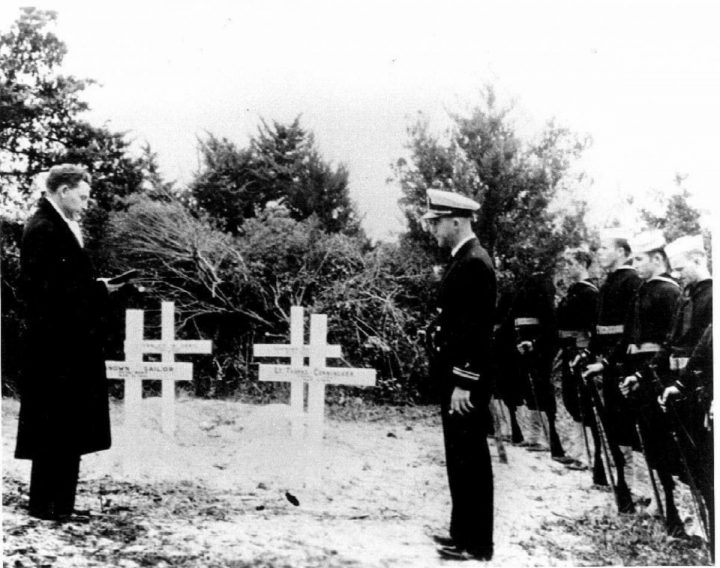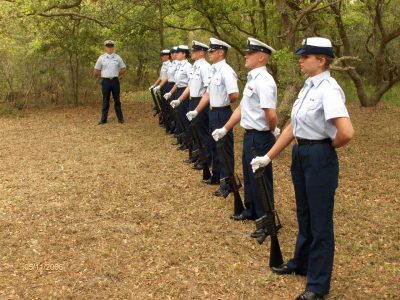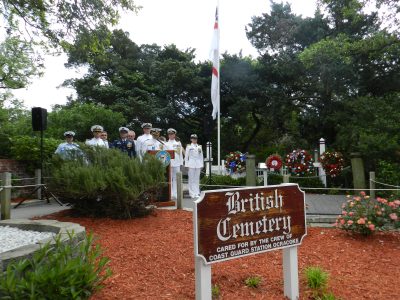
OUTER BANKS — Since the early years of World War II, two cemeteries on the Outer Banks – one near Cape Hatteras Lighthouse and the other in Ocracoke Village – have been a place of eternal rest for British soldiers, allies who sacrificed their lives while defending American shores when the United States didn’t have the resources to guard against German submarines.
Residents here have not forgotten that sacrifice. Since 1942, ceremonies have been held to commemorate these British soldiers and plans have been made to continue the tradition.
Supporter Spotlight
All are invited to join this week in recognizing the sacrifice of these soldiers during the 75th anniversary ceremonies hosted by the U.S. Coast Guard; the Coast Guard Auxiliary; the U.S. Navy; the Canadian Navy; the British Royal Navy; the Commonwealth War Graves Commission; and the National Park Service, scheduled at the British cemeteries in Buxton on Thursday and on Ocracoke Island on Friday. The ceremonies, both set for 11 a.m., are free to attend.
“Over the years, we have received tremendous community support to keep the tradition alive and the memory of these sailors who lost their lives on U.S. soil,” said Danny Couch, president of the Friends of the Graveyard of the Atlantic Museum.

The Atlantic Ocean and East Coast was a vital shipping lane for merchant ships from various nations ferrying supplies in early 1942. The U.S. Navy was not prepared for the German submarines prowling off the Atlantic coast, so these German U-boats would wait offshore to take aim and ended up sinking about 400 largely unarmed and unescorted merchant vessels.
The U.S. Navy had no ships suited for anti-submarine patrol, so the United States accepted the services of the British Royal Navy to guard against German submarines. They provided 24 Royal Navy vessels with their British crews to patrol sensitive areas along the East Coast, including North Carolina’s Outer Banks.
The Buxton military honors ceremony will recognize those who lost their lives in April 1942 when the British armed tanker San Delfino was sunk by the U-203 just off Pea Island, adjacent to Cape Hatteras National Seashore. On April 10, 1942, the unescorted San Delfino was hit by a torpedo from U-203 east of Cape Hatteras, but without any visible effect, according to the Graveyard of the Atlantic Museum. A spread of two torpedoes fired in a second attack missed, however, the next torpedo hit and sank the tanker. In all, 24 crew members and four gunners were lost. Nineteen crew members and two gunners were picked up by HMS Norwich City and landed at Morehead City. Two of the men are buried at the British cemetery in Buxton, 4th Engineer Officer Michael Cairns and an unknown sailor.
Supporter Spotlight
At the British cemetery in Ocracoke Village, the military honors ceremony will recognize the sailors from the HMS Bedfordshire, one of the vessels in the Royal Navy Patrol Service assigned to patrol the North Carolina coast that was destroyed in May 1942 by a German submarine U-558 near Ocracoke. Four bodies from the Bedfordshire were recovered on Ocracoke beaches and from the surrounding waters. The Coast Guard and Ocracoke residents buried Sub-Lt. Thomas Cunningham and Ordinary Telegraphist 2nd Class Stanley Craig near the village cemetery, along with two unknown sailors, according to the Graveyard of the Atlantic Museum.

During the ceremony, officers will place wreaths at the graves and citizens will read the names of the dead. The sounding of taps and a 21-gun salute conclude the memorial services every year. A reception will follow in the Ocracoke Community Center.
This British Cemetery is a 2,290-square-foot plot of land leased to the British government as a permanent resting place for its soldiers. Village residents are partly responsible for its care. The Ocracoke Occupancy Tax Board marks some funding for plants and the reception that follows the ceremony but the funds do not cover the total cost, according to a March article in the Ocracoke Observer. Donations to the cemetery’s preservation and the reception can be sent to the Ocracoke Civic and Business Association, P.O. Box 456, Ocracoke, NC 27960. Donors are asked to note, “British Cemetery Ceremony,” on the memo line. Volunteers also are needed. For information, call Crystal Canterbury at 252-588-2245, or email crystalcurrentlee@yahoo.com.
Canterbury is the Ocracoke representative charged with coordinating the ceremony and reception with area businesses and The Graveyard of the Atlantic Museum
“The museum personnel are instrumental in making the events successful,” she said.
Care of the cemetery is a year-round job for Canterbury, but she’s not alone in the effort. She explained that while she assists the Coast Guard with maintenance, volunteers help clean the monuments, plaques, and crosses, and residents are known to water the flowers.
Visitors to the Ocracoke British Cemetery also contribute in the form of leaving tokens at the gravesite.
“Every other month or so I remove objects from the site, per Commonwealth War Graves Commission standards, and plan to use the objects – foreign money, small crosses, notes written on shells, for example, as part of a display that will be placed in Ocracoke School,” she added.
Her interest in the Ocracoke British Cemetery extends beyond its upkeep: It sparked her interest in its history. She wrote an article about The Battle of the Atlantic for the Ocracoke Current that gives some background on why the Royal Navy Patrol Service was in Ocracoke and what happened off the North Carolina coast.
The Graveyard of the Atlantic Museum in Hatteras offers an opportunity to learn more about why the British were so involved in U.S. efforts during World War II, with its additional programming scheduled May 10.

Tom Cunningham, son of Sub-Lt. Cunningham, whose body washed ashore in Ocracoke a few days after the battle in May 1942, is slated to speak at 2 p.m. According to the Graveyard of the Atlantic Museum, Cunningham’s illustrated lecture will describe the Allied and Axis strategies before and during the battle, and how Allied technology plus a major American contribution assured victory at sea and in Europe. He will discuss the U-boat attacks and subsequent heavy ship losses suffered during 1942 off the East Coast, along with the wider activities of the Navy in the central Atlantic.
Dave Alberg, superintendent of Monitor National Marine Sanctuary, is scheduled to provide updates at 3 p.m. on the National Oceanic and Atmospheric Administration’s Battle of the Atlantic research and discuss NOAA’s partnership with the Royal Navy regarding the wreck site of HMT Bedfordshire.
“Seventy-five years ago, these young men gave their lives for our country, and it seems only appropriate that we remember their service and their sacrifice,” said Joseph Schwarzer, director of the North Carolina Maritime Museums. “It’s a real honor to have Mr. Cunningham with us this year as we recognize the 75th anniversary of the British war graves ceremonies.”
Learn More
- For more information, contact the Graveyard of the Atlantic Museum at 252-986-2995 or email clara.scarborough@ncdcr.gov
- Canterbury’s Battle of the Atlantic article
- North Carolina Maritime Museums
- Read the article from the Ocracoke Observer








